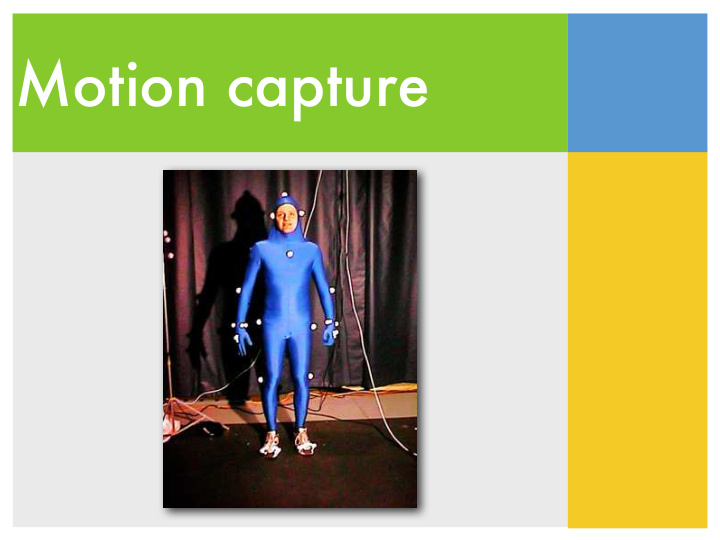



Motion capture
• Applications � • Systems � • Motion capture pipeline � • Biomechanical analysis
Applications Computer animation Biomechanics Robotics Cinema Video games Anthropology
What is captured? Objects Humans Celebrities Animals
What is captured? Face Whole body Hands
Pros and cons • Truthfully record all the fine details of the natural motion � • The captured motion is difficult to be � • generalized � • modified � • controlled
How to use the data? • Off-line � • Motion libraries � • Motion graphs � • Training examples
How to use the data? • Off-line � • Motion libraries � • Motion graphs � • Training examples � • On-line � • Drive characters based on the movement of the actors in real time
• Applications � • Systems � • Motion capture pipeline � • Biomechanical analysis
Types of Systems • Optical systems � • Magnetic systems � • Motion tapes � • Vision-based systems � • Inertial and ultrasonic systems
Optical systems • Cameras � • High temporal resolution (120+ fps) � • Detect the locations of reflective markers � • Markers � • passive: sensitive to infrared � • active: emit LED light
Magnetic system • Cumbersome sensors (heavier and also wired) � • Smaller workspace � • Record both position and orientation � • Lower resolution (80 fps max) � • Sensitive to EMI/metal in the environment
Motion tapes Contain optical fibers and sensors that can detect the bending and twisting Restriction of movement Need another technology for detecting root translation Measure the shape of surface precisely
Markerless mocap • http://www.organicmotion.com/ � • Kinect
Ultrasonic + Inertial • A wearable self-contained system � • Inertial information is provided by gyroscopes and accelerometers � • Microphones are used to record the distance between each pair of sensors
Body-mounted cameras
• Applications � • Systems � • Motion capture pipeline � • Biomechanical analysis
Motion capture pipeline calibration capturing model building marker labeling trajectory inverse smoothing kinematics
Motion capture pipeline calibration capturing model building marker labeling trajectory inverse smoothing kinematics
Calibration • Static calibration � • Figure out where the floor is � • Dynamic calibration � • Figure out the capture volume
Motion capture pipeline calibration capturing model building marker labeling trajectory inverse smoothing kinematics
Capturing • Marker placement � • Markers should move rigidly with joints � • Asymmetric placement helps in post-processing � • T-pose and range of motion � • Recording specific poses can help estimating bone lengths
3D marker position • In principle, two cameras are sufficient to reconstruct the 3D location of a marker � • In practice, more cameras can � • reduce occlusion � • increase precision
Motion capture pipeline calibration capturing model building marker labeling trajectory inverse smoothing kinematics
Model building • Given recored marker positions, estimate the dimension of each body part � • Optimize both bone length and handle positions at the same time � • Templates and heuristics help
Problem statement + generic skeleton specific pose used bone length rough handle positions for calibration handle offset
Motion capture pipeline calibration capturing model building marker labeling trajectory inverse smoothing kinematics
Marker labeling • Ghost markers � • Missing markers � • Switching trajectories
Raw data 3D locations of markers
Motion capture pipeline calibration capturing model building marker labeling trajectory inverse smoothing kinematics
Inverse kinematics • Input: articulated body with handles + desired handle positions � • Joint angles that move handles to desired positions
Motion capture pipeline calibration capturing model building marker labeling trajectory inverse smoothing kinematics
Trajectory smoothing • Global optimization that minimizes the velocity of the joint angles while staying as close as possible to the desired handle positions
Final motion
Issues The main problem with motion capture associated with characters has to do with mass distribution, weight and exaggeration. It is impossible for a performer to produce the kind of motion exaggeration that a cartoon character needs, and the mass and weight of the performer almost never looks good when applied to a character of different proportions. Eric Darnell, codirector of Antz
Issues The mapping of human motion to a character with non-human proportions doesn’t work, because the most important things you get out of motion capture are the weight shifts and the subtleties and that balancing act of the human body. If the proportions change, you throw all that out the door, so you might as well animate it. Richard Chuang, VP at PDI
Recommend
More recommend